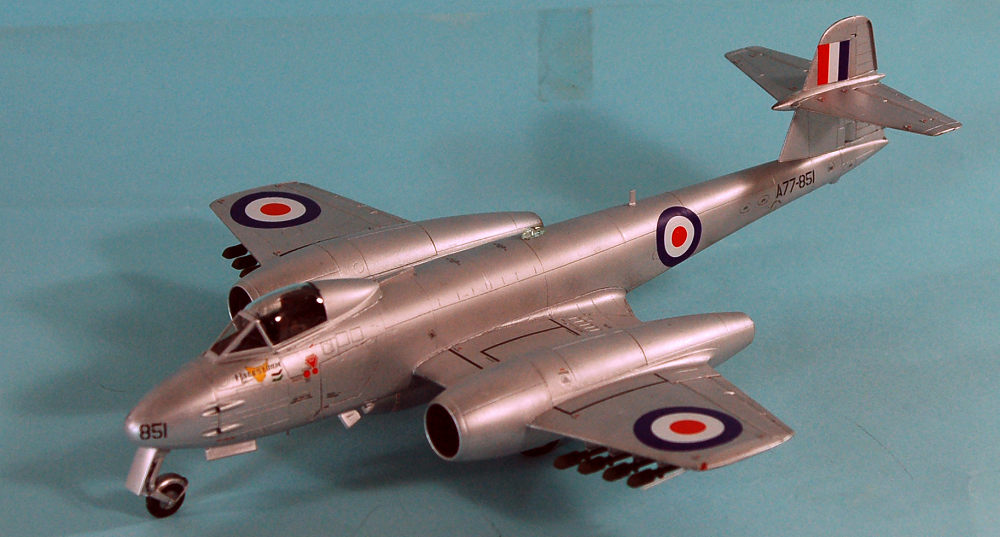
Airfix 1/48 Meteor F.8
| KIT #: | S09184 |
| PRICE: | $45.00 |
| DECALS: | Two Options |
| REVIEWER: | Tom Cleaver |
| NOTES: |

| HISTORY |
By 1947, the Meteor fighter had been in production slightly more than four years, with an airframe that was much the same as the original prototype, other than extensions of the engine nacelles which had been accomplished with the F.Mk.4 and resulted in a significant aerodynamic cleanup of the airframe with a concomitant increase in speed. The Meteor F.Mk.8 was the result of a development program on the part of Gloster Aircraft to extend the life of the Meteor line by raising the limiting Mach number.
To improve the Meteor's performance, and provide for new equipment made necessary by changing operational requirements, Gloster embarked on a major redesign of the airframe while attempting to keep as many F.4 components as possible. Most prominently, the fuselage of the Meteor 8 was lengthened by 30 inches, moving the ammunition and weapons forward the same distance, and allowing an additional 50 gallon fuel tank to be installed. It was hoped that this would also result in the deletion of the lead ballast carried in the nose of the F.4; Meteor F.4 RA382 had the lengthened nose, but it was discovered that deleting the lead ballast had the unfortunate effect of shifting the center of gravity to the rear as ammunition was expended, with increasing airframe instability.
 The solution
was discovered almost by accident. Tests were being carried out on the E.1/44
prototype in the Farnborough wind tunnel, where it was discovered that the tail
assembly of this airplane would provide the necessary control for the F.8. Once
an E.1/44 tail was grafted onto RA382, it handled beautifully without ballast.
Other improvements included a new gunsight and the Martin-Baker Mk.2 ejection
seat.
The solution
was discovered almost by accident. Tests were being carried out on the E.1/44
prototype in the Farnborough wind tunnel, where it was discovered that the tail
assembly of this airplane would provide the necessary control for the F.8. Once
an E.1/44 tail was grafted onto RA382, it handled beautifully without ballast.
Other improvements included a new gunsight and the Martin-Baker Mk.2 ejection
seat.
The first F.8 prototype, VT150, made its first flight on October 12, 1948. A further change was made when it was discovered that the under-fuselage ejection slots for spent shell casings was scoring the belly tank and rear fuselage; large external chutes were fitted to the slots to carry the shell casings clear. A pair of Rolls-Royce Derwent 8s gave the F.Mk.8 a top speed of 590 m.p.h. Later, the size of the air intakes was increased by 4.5 inches in diameter, which resulted in an extra 200 pounds of thrust for each engine due to the increased air mass available. This resulted in a top speed of around 600 m.p.h.
The first F.8, VZ438, was handed over to the RAF on December 10, 1949, while the last - WL191 - left the assembly line on April 9, 1954.
The Meteor in Australian Service in Korea:
The veteran 77 Squadron, equipped with Mustang IVs, entered combat in Korea in the summer of 1950, operating in close air support. The unit gave crucial support to the 1st Marine Division during the legendary “Breakout from Chosin.”
In
1951, the RAAF decided to upgrade the equipment of 77 Squadron so that they
might take part in the air battles being fought over North Korea by the USAF.
The squadron’s leadership and pilots unanimously recommended the RAAF obtain
F-86 Sabres, but the RAAF was unsuccessful in obtaining the Sabre before 1954,
since priority was given to re-equipping USAF units. The Australian government
determined they
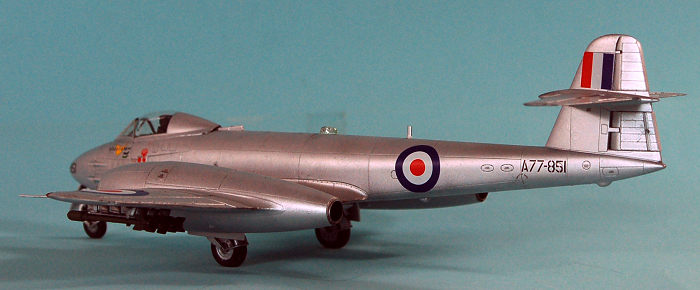 would take
the best British fighter, and 36 F.8s and four T.7 trainers were delivered. 77
Squadron re-equipped with the Meteor F.8 between April-July 1951.
would take
the best British fighter, and 36 F.8s and four T.7 trainers were delivered. 77
Squadron re-equipped with the Meteor F.8 between April-July 1951.
On 29 July 1951, 22 F.8s were deployed to Kimpo Air Base in Korea. In August the unit - operating under control of the USAF 4th Fighter Interceptor Wing - began escorting B-29s. The Meteors first engaged MiG-15s on 25 August, but scored no hits. On 29 August, eight Meteors and 16 Sabres fought 12 MiG-15s. One RAAF pilot ejected when his aircraft was shot down, and a second Meteor was badly damaged. One week later another Meteor suffered severe damage in a dogfight with MiGs.
Flight Lieutenant "Smoky" Dawson registered 77 Squadron's first jet claim when he damaged a MiG-15 during an escort mission near Anju, North Korea, on 26 September 1951. On 27 October, Flying Officer Les Reading was credited with damaging another MiG-15 while covering B-29s over Sinanju; it was subsequently confirmed as having been destroyed, making it the squadron's first MiG "kill". 77 Squadron was awarded the Republic of Korea Presidential Unit Citation for "exceptionally meritorious service & heroism" on 1 November.
On 1 December 1951, over Sunchon, 20 Soviet-piloted MiG-15s from the 176th Guards Fighter Air Regiment (176 GvIAP) attacked 14 Meteors. Both sides overestimated the scale of battle and damage inflicted to their opponents: Soviet pilots claimed nin destroyed though only three Meteors were lost, while the Australians claimed one MiG-15 shot down and another damaged, though Russian sources suggest that all the MiGs returned to base.
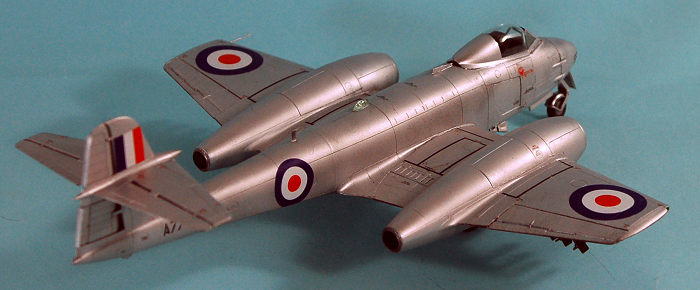 In a
controversial decision, the Meteors were withdrawn from combat and assigned as
air defense to Kimpo, standing alert, since they were considered outclassed by
the MiG-15. This lasted until early 1952, when the squadron returned to a
primary mission of ground attack. The Meteor was relatively silent on approach
to a target, and its low altitude acceleration and maneuverability gave it good
survival chances in the battlefield environment.
In a
controversial decision, the Meteors were withdrawn from combat and assigned as
air defense to Kimpo, standing alert, since they were considered outclassed by
the MiG-15. This lasted until early 1952, when the squadron returned to a
primary mission of ground attack. The Meteor was relatively silent on approach
to a target, and its low altitude acceleration and maneuverability gave it good
survival chances in the battlefield environment.
They continued to operate mainly in the ground-attack role until the end of the war, but registered two more victories over MiGs near Pyongyang on 4 and 8 May 1952, when Flt. Sergeant George Hale claimed one damaged and one destroyed.
The squadron took part in many attacks in North Korea in the final 18 months of the conflict. Losses amounted to 25% of pilots killed or captured. Following the armistice in July 1953, 77 Squadron remained in Korea until November 1954 when it finally returned to Australia after 11 years of overseas service.
| THE KIT |
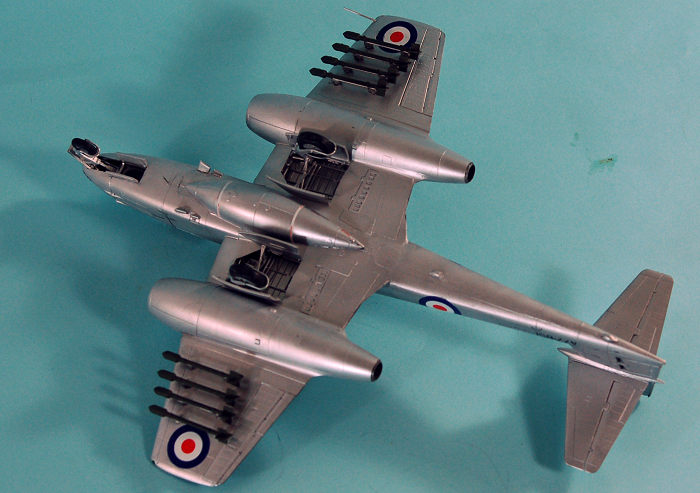 This is the
second release of the Meteor F.8. The kit now includes a sprue that has eight
rocket rails and rocket projectiles. It is also molded in the UK and is superior
to the initial release in that the plastic is less soft, leading to better fit.
The clear parts are also much more clear since they were not pulled out of the
mold too soon as happened with the first release. The kit is logically
laid out, with crisp molding and surface detail that looks good under the
proverbial “coat of paint.”
This is the
second release of the Meteor F.8. The kit now includes a sprue that has eight
rocket rails and rocket projectiles. It is also molded in the UK and is superior
to the initial release in that the plastic is less soft, leading to better fit.
The clear parts are also much more clear since they were not pulled out of the
mold too soon as happened with the first release. The kit is logically
laid out, with crisp molding and surface detail that looks good under the
proverbial “coat of paint.”
The early framed canopy has the bulged clear section that has eluded the makers of previous Meteor F.8 kits. Decals are provided for two 77 Squadron Meteors including “Halestorm,” the victor in the last aerial combat the RAAF has engaged in, and a Royal Netherlands Air Force Meteor in air display team markings.
| CONSTRUCTION |
Compared to the truly wretched Classic Airframes “putty monsters,” the Airfix Meteor is nearly trouble-free. It’s not totally trouble-free, but the problems that exist are easily solved and certainly nowhere near the difficulty and problems of the earlier kits. This was my second kit of the Meteor, and my construction technique profited from having found the minefield “the hard way” the first time. If you follow what I did here, you too will have a trouble-free build.
I found that the Airfix instructions that have one not attach the nose cone until the fuselage and cone have been assembled separately leads to fit problems. What I did this time was glue the nose cone halves to the respective fuselage halves prior to further assembly. This got the fit perfect, and also guaranteed I would attach the nose gear properly.
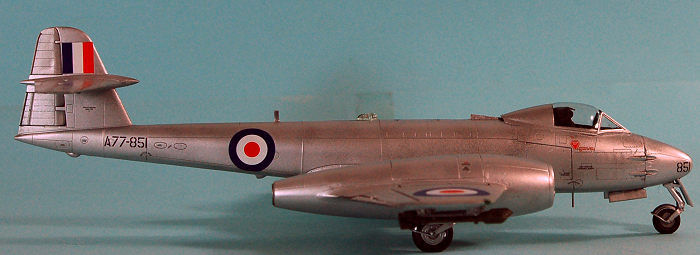 Modelers have
noted problems with the fuselage-wing fairing pieces, with some modelers finding
that there is a substantial gap between the fuselage and upper wing when the two
sub-assemblies are joined. This is a modeler-induced problem. I attached the
fuselage/wing fairing parts to their respective fuselage halves prior to further
assembly, which allowed me to work the joint from both sides and get it
absolutely perfectly aligned with the surrounding fuselage half. This insured
that there would be no wing-fuselage gap when I attached the wing sub-assembly
to the fuselage sub-assembly. In fact, with this kit I only had to use a bit of
Mr. Surfacer on the fuselage centerline seam; everything else had fit just
right.
Modelers have
noted problems with the fuselage-wing fairing pieces, with some modelers finding
that there is a substantial gap between the fuselage and upper wing when the two
sub-assemblies are joined. This is a modeler-induced problem. I attached the
fuselage/wing fairing parts to their respective fuselage halves prior to further
assembly, which allowed me to work the joint from both sides and get it
absolutely perfectly aligned with the surrounding fuselage half. This insured
that there would be no wing-fuselage gap when I attached the wing sub-assembly
to the fuselage sub-assembly. In fact, with this kit I only had to use a bit of
Mr. Surfacer on the fuselage centerline seam; everything else had fit just
right.
I added as many fishweights as I could squeeze into the area behind the cockpit between the cannon bays to insure nose-sitting. I also used the kit ejection seat, with the part that had the molded-in seatbelts. A resin seat would look good here, but given that everything including the seat is flat black, the kit part is just fine. Since the canopy was so clear, I decided to do this model with the canopy closed. I attached the landing gear at this time, without the wheels, which I attached later.
| COLORS & MARKINGS |
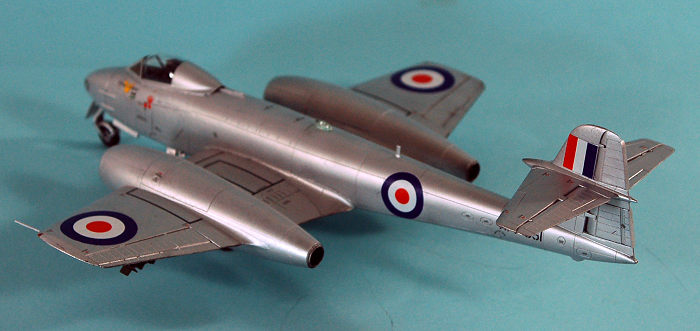 I gave the
model an overall coat of Tamiya Gloss Black X-1 for a primer, then airbrushed
Vallejo “White Aluminum” over the entire frame, which makes a good approximation
of High Speed Silver. When that was dry I applied a coat of Micro-coat Gloss.
I used the kit decals for George Hales “Halestorm.”
I gave the
model an overall coat of Tamiya Gloss Black X-1 for a primer, then airbrushed
Vallejo “White Aluminum” over the entire frame, which makes a good approximation
of High Speed Silver. When that was dry I applied a coat of Micro-coat Gloss.
I used the kit decals for George Hales “Halestorm.”
When the decals were set, I washed the model to get rid of any dried decal solvent, then gave the model a coat of Clear Flat, which has a slight sheen, and provides an approximation of how the painted surface would have looked after a year’s service in Korea.
I then attached the rocket rails and the rockets, and the gear wheels.
| CONCLUSIONS |
This kit is light years better than the old Classic Airframes kits, which can safely be turned into the door stops they have always aspired to be. The kit is easy to assemble if you take care with the details mentioned above, and the result is a really outstanding model, however you finish and mark it. As mentioned, this second release is a superior kit as regards molding and plastic quality.
1 March 2018 Copyright ModelingMadness.com Review kit courtesy of Hornby USA. If you would like your product reviewed fairly and
fairly quickly, please
contact
the editor or see other details in the
Note to
Contributors.